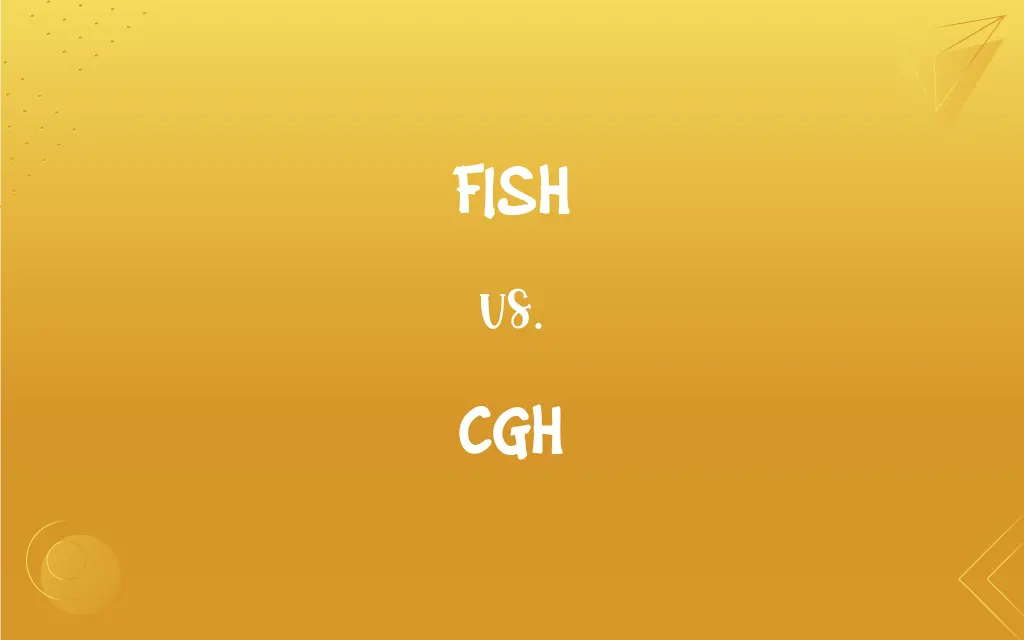FISH vs. CGH: What's the Difference?
Edited by Aimie Carlson || By Harlon Moss || Published on March 4, 2024
Fish are aquatic animals with gills and fins, while CGH (Comparative Genomic Hybridization) is a molecular cytogenetic method for analyzing DNA copy number variations.

Key Differences
Fish are living organisms in water, characterized by gills, fins, and typically scales. CGH, on the other hand, is a laboratory technique used for the detection of DNA copy number variations in the genome.
The term fish encompasses a diverse group of species, inhabiting various aquatic environments. CGH is a tool in genetic research and diagnostics, providing insights into genomic alterations.
Fish play a crucial role in aquatic ecosystems and are a major source of food for humans. Comparative Genomic Hybridization is utilized in medical research to study genetic disorders and cancers.
Biological classification places fish in several taxonomic groups based on their evolutionary history. CGH operates on a molecular level, comparing DNA samples to detect genetic differences or anomalies.
In terms of their contribution to science, fish are used in research studies for understanding ecology, physiology, and evolution. CGH contributes significantly to the field of genomics, offering a comprehensive view of chromosomal changes.
ADVERTISEMENT
Comparison Chart
Nature
Aquatic animals with distinct biological features
A molecular cytogenetic method for DNA analysis
Role
Inhabit aquatic environments, serve as food
Analyzes DNA copy number variations in genomes
Application
Ecological, commercial, and research significance
Used in genetic research and medical diagnostics
Classification
Classified based on evolutionary biology
A laboratory technique in the field of genomics
Contribution to Science
Studied for ecological and physiological insights
Provides insights into genetic disorders and cancer research
ADVERTISEMENT
FISH and CGH Definitions
FISH
Characterized by gills, fins, and often scales.
Goldfish are popular pets known for their distinctive fins.
CGH
Helps in identifying genetic gains or losses in chromosomes.
CGH can reveal chromosomal changes in cancer cells.
FISH
Fish occupy diverse habitats in oceans, lakes, and rivers.
Clownfish are typically found in coral reefs.
CGH
Used in prenatal testing and cancer diagnostics.
CGH helps detect genetic abnormalities in prenatal screening.
FISH
Many species serve as a vital food source for humans.
Tuna is a commonly consumed fish worldwide.
CGH
A genomic technique for analyzing DNA copy number variations.
CGH is used to detect duplications or deletions in chromosomes.
FISH
Used in scientific research to study marine biology.
Zebrafish are often used in genetic research.
CGH
Utilizes fluorescent labeling to compare DNA samples.
In CGH, different colored dyes represent the test and reference DNA.
FISH
Cold-blooded vertebrate animals living in water.
Salmon are a type of fish known for their migration patterns.
CGH
Contributes to research in genetics and genomic medicine.
CGH has advanced understanding in genetic disorders.
FISH
Any of numerous cold-blooded aquatic vertebrates characteristically having fins, gills, and a streamlined body and including the bony fishes, such as catfishes and tunas, and the cartilaginous fishes, such as sharks and rays.
FISH
Any of various jawless aquatic craniates, including the lampreys and hagfishes.
FAQs
What is CGH used for?
For analyzing DNA copy number variations in genetic research.
Can fish live in both freshwater and saltwater?
Yes, some fish species can adapt to both environments.
How does CGH contribute to cancer research?
It helps identify genetic alterations in cancer cells.
Can CGH detect all types of genetic disorders?
It's effective for copy number variations but not for single-gene mutations.
How accurate is CGH in genetic diagnosis?
It's highly accurate for detecting large-scale genomic changes.
Do fish play an ecological role?
Yes, they are integral to aquatic food webs and ecosystems.
What is the biological classification of fish?
They are classified into groups like bony fish and cartilaginous fish.
Are fish used in scientific research?
Yes, for studies in ecology, physiology, and genetics.
Is CGH a time-consuming process?
It can be, depending on the complexity of the sample.
What are the main characteristics of fish?
Fish are aquatic, cold-blooded vertebrates with gills and fins.
What is the diet of most fish?
It varies widely, from plankton to other fish.
Do fish have a social structure?
Some species exhibit complex social behaviors and hierarchies.
What type of DNA changes can CGH identify?
It identifies duplications and deletions of DNA segments.
What are the limitations of CGH?
It can't detect balanced rearrangements or point mutations.
Are all fish species edible?
Not all; some fish are toxic or not suitable for consumption.
Can CGH be used for prenatal testing?
Yes, it's used for detecting chromosomal abnormalities in fetuses.
Is CGH applicable in personalized medicine?
Yes, especially in tailoring cancer treatments based on genetic profiles.
How do fish reproduce?
Most fish lay eggs, but some give live birth.
How does CGH compare to other genetic tests?
CGH specifically assesses copy number variations, unlike sequence-specific tests.
Can fish communicate with each other?
Some species use sounds, movements, or electrical signals.
About Author
Written by
Harlon MossHarlon is a seasoned quality moderator and accomplished content writer for Difference Wiki. An alumnus of the prestigious University of California, he earned his degree in Computer Science. Leveraging his academic background, Harlon brings a meticulous and informed perspective to his work, ensuring content accuracy and excellence.
Edited by
Aimie CarlsonAimie Carlson, holding a master's degree in English literature, is a fervent English language enthusiast. She lends her writing talents to Difference Wiki, a prominent website that specializes in comparisons, offering readers insightful analyses that both captivate and inform.







































































